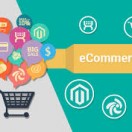E-commerce (electronic commerce) is the activity of electronically buying or selling of products on online services or over the Internet. Electronic commerce draws on technologies such as mobile commerce, electronic funds transfer, supply chain management, Internet marketing, online transaction processing, electronic data interchange (EDI), inventory management systems, and automated data collection systems. E-commerce is in turn driven by the technological advances of the semiconductor industry, and is the largest sector of the electronics industry.
Modern electronic commerce typically uses the World Wide Web for at least one part of the transaction's life cycle although it may also use other technologies such as e-mail. Typical e-commerce transactions include the purchase of online books (such as Amazon) and music purchases (music download in the form of digital distribution such as iTunes Store), and to a less extent, customized/personalized online liquor store inventory services. There are three areas of e-commerce: online retailing, electronic markets, and online auctions. E-commerce is supported by electronic business.
E-commerce businesses may also employ some or all of the followings:
Online shopping for retail sales direct to consumers via Web sites and mobile apps, and conversational commerce via live chat, chatbots, and voice assistants
Providing or participating in online marketplaces, which process third-party business-to-consumer (B2C) or consumer-to-consumer (C2C) sales
Business-to-business (B2B) buying and selling;
Gathering and using demographic data through web contacts and social media
Business-to-business (B2B) electronic data interchange
Marketing to prospective and established customers by e-mail or fax (for example, with newsletters)
Engaging in pretail for launching new products and services
Online financial exchanges for currency exchanges or trading purposes.
Some common applications related to electronic commerce are:
B2B e-commerce (business-to-business)
B2C e-commerce (business-to-consumer)
Conversational commerce: e-commerce via chat
Digital Wallet
Document automation in supply chain and logistics
Electronic tickets
Enterprise content management
Group buying
Instant messaging
Internet security
Online auction
Online banking
Online office suites
Online shopping and order tracking
Online transaction processing
Pretail
Print on demand
Shopping cart software
Social networking
Teleconference
Usenet newsgroup
Virtual assistant
Domestic and international payment systems
Logistics in e-commerce mainly concerns fulfillment. Online markets and retailers have to find the best possible way to fill orders and deliver products. Small companies usually control their own logistic operation because they do not have the ability to hire an outside company. Most large companies hire a fulfillment service that takes care of a company's logistic needs.
Contrary to common misconception, there are significant barriers to entry in e-commerce.
The contemporary e-commerce trend recommends companies to shift the traditional business model where focus on "standardized products, homogeneous market and long product life cycle" to the new business model where focus on "varied and customized products". E-commerce requires the company to have the ability to satisfy multiple needs of different customers and provide them with wider range of products.
With more choices of products, the information of products for customers to select and meet their needs become crucial. In order to address the mass customization principle to the company, the use of recommender system is suggested. This system helps recommend the proper products to the customers and helps customers make the decision during the purchasing process. The recommender system could be operated through the top sellers on the website, the demographics of customers or the consumers' buying behavior. However, there are 3 main ways of recommendations: recommending products to customers directly, providing detailed products' information and showing other buyers' opinions or critiques. It is benefit for consumer experience without physical shopping. In general, recommender system is used to contact customers online and assist finding the right products they want effectively and directly

